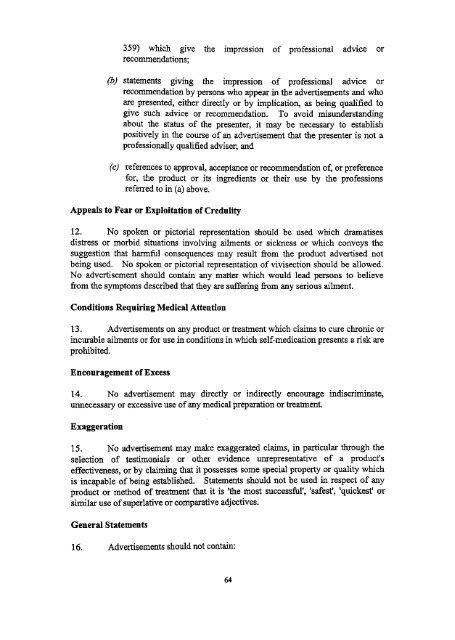(a) m - HKU Libraries - The University of Hong Kong
(a) m - HKU Libraries - The University of Hong Kong
(a) m - HKU Libraries - The University of Hong Kong
Create successful ePaper yourself
Turn your PDF publications into a flip-book with our unique Google optimized e-Paper software.
359) which give the impression <strong>of</strong> pr<strong>of</strong>essional advice or<br />
recommendations;<br />
(b) statements giving the impression <strong>of</strong> pr<strong>of</strong>essional advice or<br />
recommendation by persons who appear in the advertisements and who<br />
are presented, either directly or by implication, as being qualified to<br />
give such advice or recommendation. To avoid misunderstanding<br />
about the status <strong>of</strong> the presenter, it may be necessary to establish<br />
positively in the course <strong>of</strong> an advertisement that the presenter is not a<br />
pr<strong>of</strong>essionally qualified adviser; and<br />
(c) references to approval, acceptance or recommendation <strong>of</strong>, or preference<br />
for, the product or its ingredients or their use by the pr<strong>of</strong>essions<br />
referred to in (a) above.<br />
Appeals to Fear or Exploitation <strong>of</strong> Credulity<br />
12. No spoken or pictorial representation should be used which dramatises<br />
distress or morbid situations involving ailments or sickness or which conveys the<br />
suggestion that harmful consequences may result from the product advertised not<br />
being used. No spoken or pictorial representation <strong>of</strong> vivisection should be allowed.<br />
No advertisement should contain any matter which would lead persons to believe<br />
from the symptoms described that they are suffering from any serious ailment.<br />
Conditions Requiring Medical Attention<br />
13. Advertisements on any product or treatment which claims to cure chronic or<br />
incurable ailments or for use in conditions in which self-medication presents a risk are<br />
prohibited.<br />
Encouragement <strong>of</strong> Excess<br />
14. No advertisement may directly or indirectly encourage indiscriminate,<br />
unnecessary or excessive use <strong>of</strong> any medical preparation or treatment.<br />
Exaggeration<br />
15. No advertisement may make exaggerated claims, in particular through the<br />
selection <strong>of</strong> testimonials or other evidence unrepresentative <strong>of</strong> a product's<br />
effectiveness, or by claiming that it possesses some special property or quality which<br />
is incapable <strong>of</strong> being established. Statements should not be used in respect <strong>of</strong> any<br />
product or method <strong>of</strong> treatment that it is 'the most successful 1 , 'safest 1 , 'quickest' or<br />
similar use <strong>of</strong> superlative or comparative adjectives.<br />
General Statements<br />
16. Advertisements should not contain:<br />
64

















